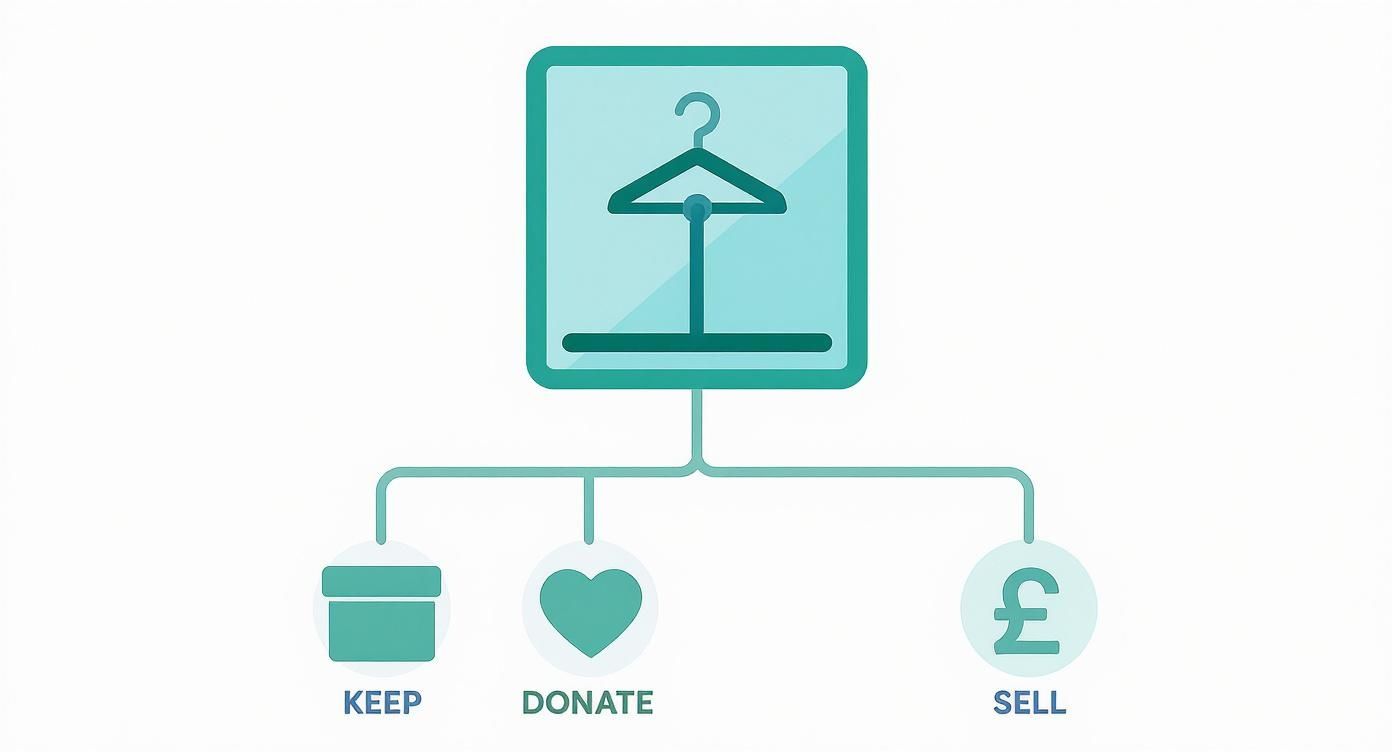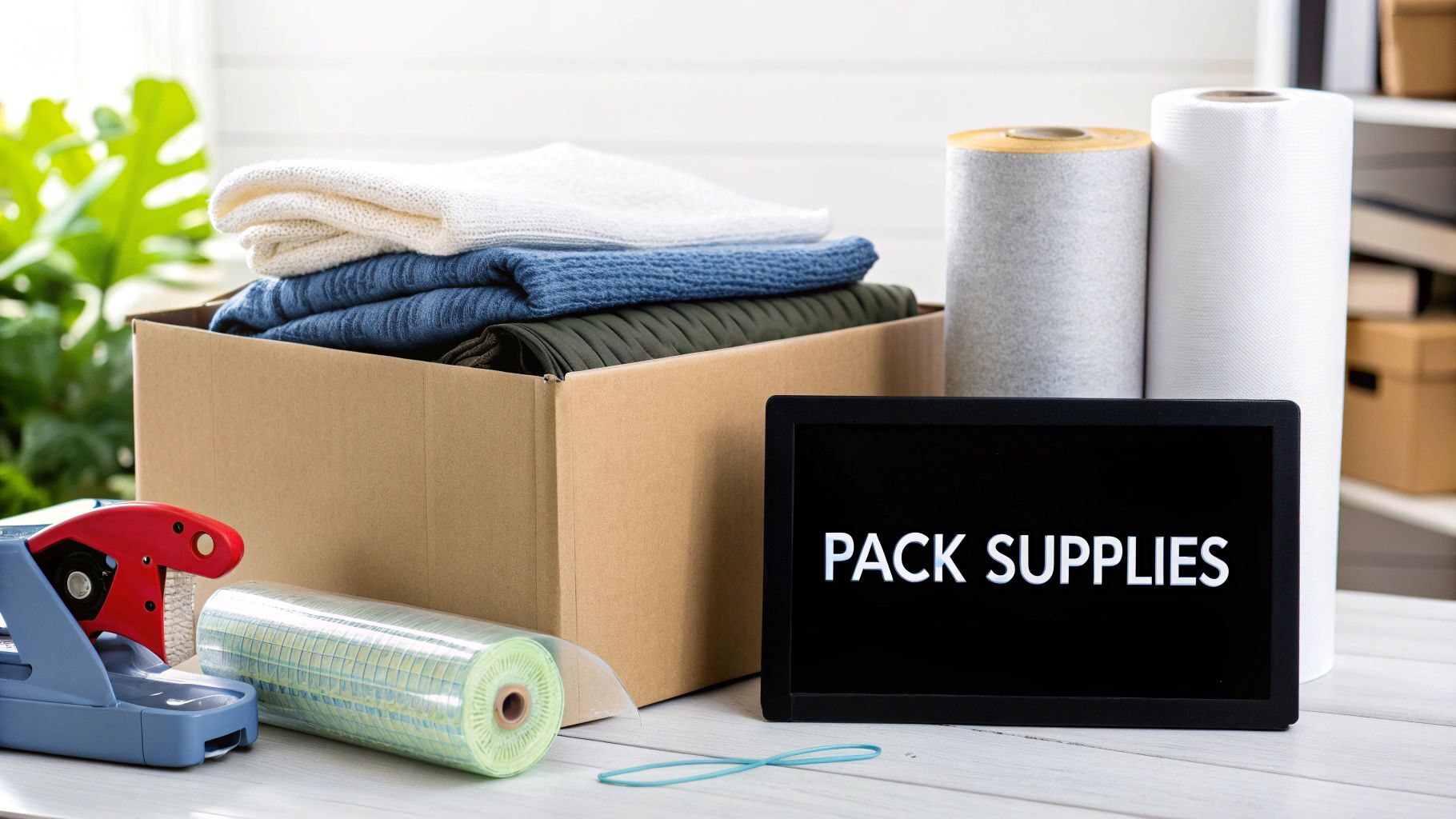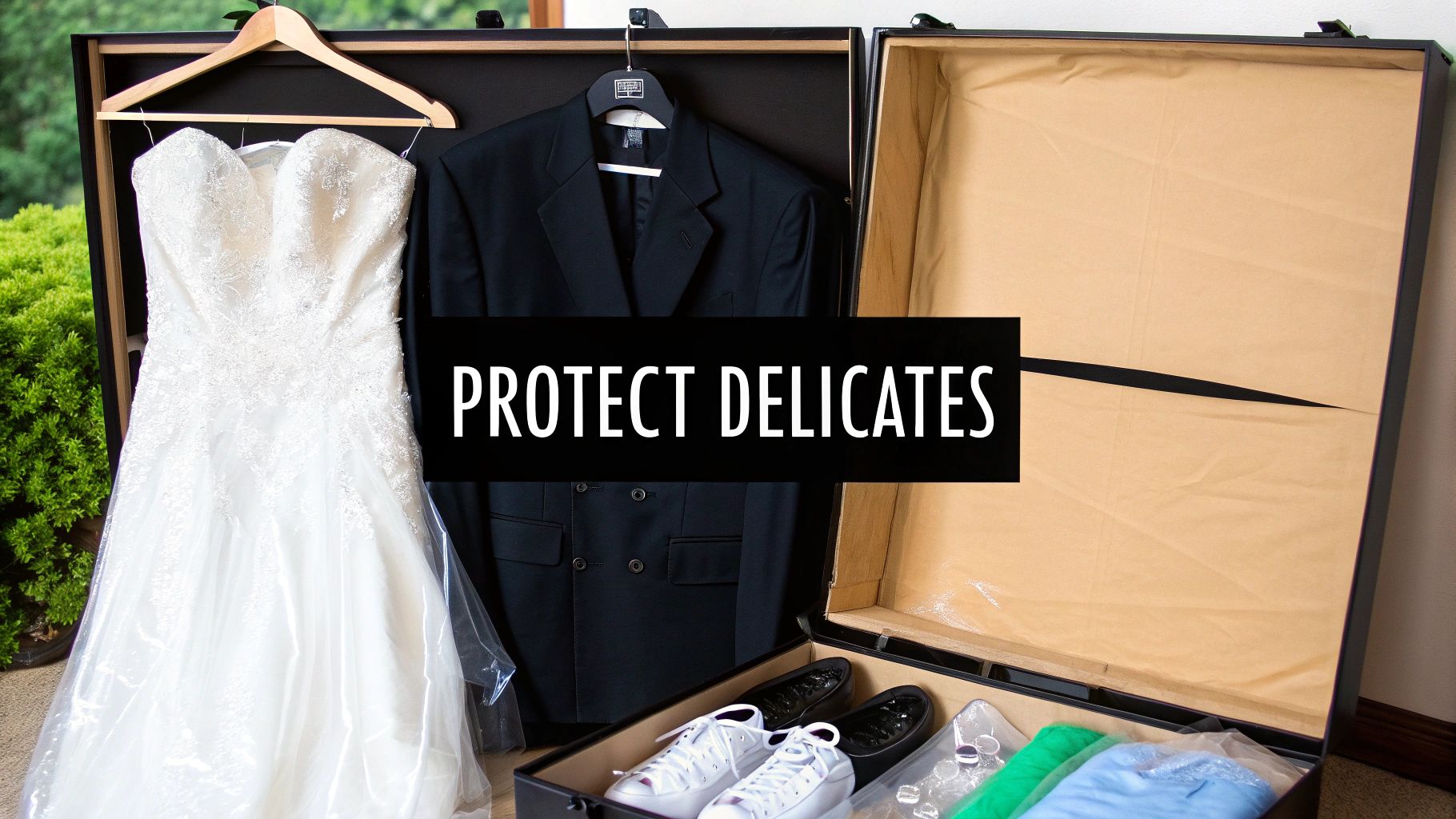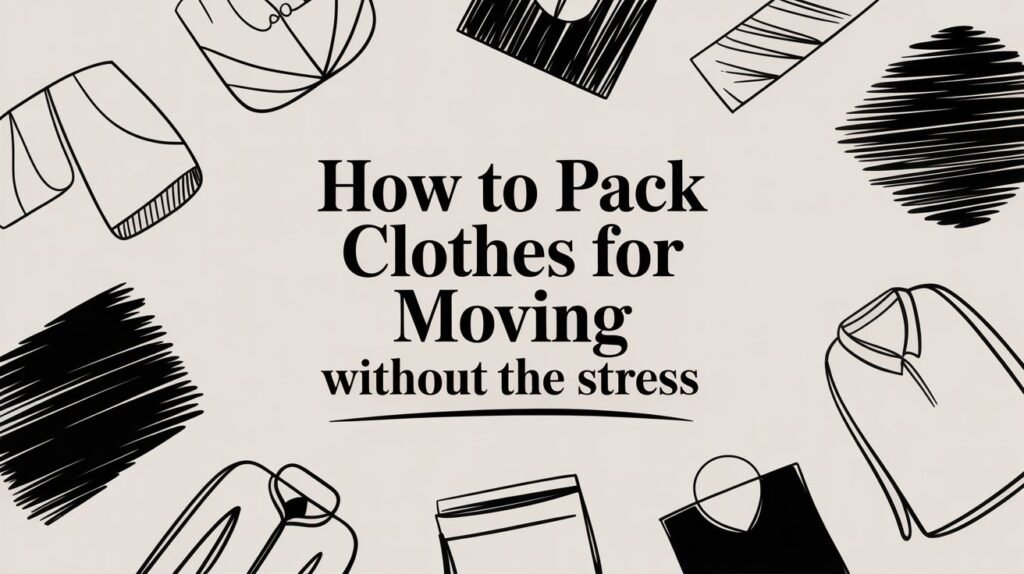Packing your entire wardrobe can feel like one of the most daunting tasks on your moving checklist. The secret to making it manageable? Start with a ruthless declutter. Sorting everything into keep, donate, and sell piles before you even think about boxes will save you a world of hassle later on.
Your Moving Prep Starts Here
Before you even touch a roll of packing tape, the most important thing you can do is lighten your load. A proper wardrobe clear-out simplifies the packing process and means fewer boxes to haul, which saves you both time and money.
With around 6,000 house moves happening every day in the UK, having a solid system is non-negotiable. As someone who has seen it all, I can tell you that removal companies often say delays are caused by last-minute packing frenzies—a problem that a little bit of planning easily solves.
This initial sorting stage sets the tone for your entire move. By deciding what to do with each item before you gather supplies, you create a clear, actionable plan.
Decide What to Keep, Donate, or Sell
The first big decision is what happens to everything you pull out of your wardrobe and drawers. If you love it and wear it regularly, it’s a keeper. If it’s in great nick but just not your style anymore, it’s perfect for selling or donating.
This simple decision-making process helps you cut through the clutter with three clear outcomes.

This visual is a great reminder that every single item should have a destination before you start figuring out how to pack clothes for moving. Once that’s sorted, you can move on to getting the right supplies.
A good rule of thumb if you’re on the fence is the one-year test. If you haven't worn something in the last 12 months (special occasion outfits aside), it’s probably time to let it go.
Once you’ve whittled everything down to your "keep" pile, you can finally focus on packing. You'll know exactly how much you have, which makes gathering the right materials so much easier. To see how this fits into the bigger picture, take a look at our guide on what to pack first when moving. This proactive approach transforms chaos into a calm, organised task and sets you up for a much smoother move.
Gathering the Right Packing Supplies
Right, so you’ve decided what's coming with you. The next move is to get your hands on the right gear. Honestly, this part can make or break the whole process. Using proper supplies is the difference between a smooth, organised move and a chaotic mess where you spend days hunting for a single jumper. It’s not just about chucking things in boxes; it's about making smart choices for different bits of your wardrobe.

Think of it this way: investing in good packing materials now will save you a world of stress when it's time to unpack. Quality supplies protect your clothes and just make everything that much easier.
Your Non-Negotiable Clothing Packing Kit
The containers you choose will have a massive impact on how well your clothes survive the journey. I’ve seen it all over the years, and a few items are absolutely essential for keeping your wardrobe in great nick.
- Wardrobe Boxes: These are a total game-changer, especially for suits, dresses, coats, and anything you don't want creased. They're basically tall boxes with a hanging rail inside. You just lift your clothes straight from your wardrobe and hang them in the box. When you arrive, they’re wrinkle-free and ready to go.
- Vacuum-Seal Bags: If you have bulky winter coats, ski gear, or chunky jumpers, you need these. They suck all the air out and shrink everything down to a surprisingly small size. It’s amazing how much space you’ll save in the moving van.
- Sturdy Suitcases: Don't let your luggage sit empty! Suitcases are perfect for packing the clothes you’ll need for the first few days in your new place. This way, you have a ready-made ‘essentials kit’ without rummaging through endless boxes.
- Quality Boxes and Tape: For all your folded clothes, standard cardboard boxes are fine. For a more durable and reusable option, you could also look into things like plastic stacking storage boxes. And please, don't skimp on the packing tape. I can't tell you how many times I've seen a cheap box split open at the worst possible moment.
Here’s a personal tip I always give clients: use plain packing paper or tissue paper for anything delicate. Newspaper is a classic mistake – the ink can easily rub off onto light-coloured fabrics, and those stains can be a real pain to get out later on.
Essential Labelling and Protection Tools
Knowing what's in every box is the secret to a fast, organised unpack. A simple, clear system will save you from that frantic moment of opening ten different boxes just to find a clean pair of socks.
Your labelling kit is simple but vital:
- Permanent Markers: A few thick, black markers are a must for writing clearly on each box.
- Colour-Coded Labels: Try assigning a colour to each room—say, blue for the main bedroom, green for the kitchen. It makes it dead simple for movers (or helpful friends) to put boxes exactly where they need to go.
Getting all this stuff together before you start packing is the key. For a more detailed look at what you might need, this guide on packing materials for moving house is a great resource. When you have everything on hand from the get-go, the whole job feels less like a monumental chore and more like a well-oiled machine.
Smart Packing Techniques for Every Item
You’ve got your supplies, so now it’s time to get stuck into the actual packing. The technique you choose isn't just about getting clothes into a box; it's about saving space, preventing damage, and making life so much easier when you're unpacking at the other end. Different garments and fabrics call for different methods.

Your packing strategy is also shaped by your reasons for moving. Current trends in British housing show that big lifestyle changes and the simple need for more room are huge motivators. In fact, a recent survey found 15% of people moved to get a larger home, which usually means having to pack up a lot more seasonal gear and specialised clothing. Knowing this should help you plan—it’s always best to pack those less-used items first.
The Rolling Method for Everyday Wear
For all your casual gear—t-shirts, jeans, jumpers, and pyjamas—the rolling method is an absolute game-changer. Don't fold them flat. Instead, lay each item face down, fold in the sleeves, and roll it up tightly from the bottom. It’s amazing how much this compacts your clothes, letting you squeeze far more into a box or suitcase.
Another massive plus? Tightly rolled clothes are much less likely to develop those deep, stubborn creases you get from folding. That means a smaller mountain of ironing to face when you arrive.
Pro Tip: Rolling turns your clothes into neat little cylinders. Try packing them vertically in your boxes, like a filing system. You'll be able to see everything at a glance without rummaging through endless layers.
Strategic Folding for Delicate Items
Of course, rolling isn't the right call for every garment. Delicate materials like silk, cashmere, or even linen can easily get stretched or damaged if you roll them too tightly. For these more precious pieces, stick with a careful, traditional fold.
- Find a Flat Surface: Lay the garment out on a clean, flat space.
- Add Tissue Paper: Place a sheet of acid-free tissue paper on top before you fold. This simple step reduces friction and helps prevent snagging.
- Keep Folds Minimal: Make as few folds as you can to fit the item in the box. A silk blouse, for instance, might only need to be folded in half once with the sleeves tucked over.
This gentle approach preserves the fabric and stops permanent creases from setting in during the move. Just remember to place these lighter, folded items on the very top of a box so they don't get squashed.
Organise with Packing Cubes
Packing cubes are a lifesaver. These little zipped bags let you group similar items together, essentially creating mini-drawers inside your moving boxes. You could have one cube for all your socks and underwear, another for your gym kit, and a separate one for sleepwear.
Once you’ve moved in, you won't need to tip a whole box upside down just to find a pair of socks. You can just grab the cube you need. They are particularly brilliant for your ‘first night’ essentials box, keeping everything you need immediately accessible.
If your clothes are going to be in transit or storage for a while, think about preservation. It's one thing to pack for a quick move, but for longer-term situations, following some tips on how to store clothes properly can protect them from damp, pests, and damage.
Protecting Delicate Clothes and Accessories
Let’s be honest, not everything in your wardrobe can be unceremoniously rolled into a ball and shoved into a box. Your most valuable and delicate pieces—from that impeccably tailored suit to your favourite pair of heels—demand a bit more finesse to arrive at your new home in pristine condition. Putting in a little extra effort now saves you from the heartache of damage later and ensures these items are ready to wear the moment you need them.

The name of the game here is creating protective layers and maintaining the structure of each item. A little forethought when packing these special clothes and accessories means you won't be faced with crushed handbags, scuffed shoes, or a tangled bird's nest of jewellery when you unpack.
Safeguarding Formalwear and Suits
When it comes to evening gowns, blazers, and suits, the main goal is to minimise creasing and protect the fabric. The best way to think about it is that you're not just packing them, you're moving your wardrobe itself.
Your first step should be to place each item in its own garment bag. This gives you an immediate line of defence against dust, moisture, and potential snags from other items. From there, transfer them directly into a proper wardrobe box. This lets the clothes hang naturally during the move, which is by far the most effective way to prevent those deep-set wrinkles that can be a real pain to steam out later.
Here's a simple but brilliant tip I've picked up over the years: button up jackets and zip up dresses before hanging them in the wardrobe box. It really helps the garment hold its natural shape and stops it from sloshing around inside the bag.
The Right Way to Pack Shoes
Shoes are so often an afterthought, but packing them incorrectly can lead to irreversible damage like scuffs, crushed heels, or misshapen toe boxes. Whatever you do, don't just toss them all into a box together. A bit of prep work makes a world of difference.
- Maintain Their Shape: Stuff each shoe with a pair of rolled-up socks or some acid-free tissue paper. This is absolutely crucial for leather shoes, boots, and heels, as it stops them from getting squashed flat.
- Prevent Scuffs: Wrap each shoe individually. You can use packing paper, a dedicated dust bag, or even an old t-shirt. This creates a barrier so that buckles, zips, and rough materials can't scratch up other pairs.
- Box Them Up: Once wrapped, pack them snugly into a sturdy box. Always place heavier pairs like boots at the bottom and arrange lighter shoes and sandals on top.
Following this method not only keeps your footwear protected but also makes finding the pair you want much easier.
Organising Jewellery and Accessories
Small accessories have a knack for getting lost, broken, or tangled during a move. Necklaces become a knotted disaster, belts get bent out of shape, and that one specific earring seems to vanish into thin air. The trick is simply to keep everything separate and securely contained.
For jewellery, a dedicated travel organiser or even small, individual pouches will stop items from scratching each other. A great DIY hack is to thread delicate necklaces through drinking straws—it’s a surprisingly effective way to stop them from tangling. Roll up your belts and place them inside a small box or a drawer organiser to help them keep their shape. Scarves can be neatly folded and placed in a packing cube or a lined box to prevent snagging on rough cardboard.
Here's a quick checklist to help you get it right for your most precious items.
Special Care Item Packing Checklist
| Item | Recommended Packing Material | Key Tip |
|---|---|---|
| Suits/Gowns | Garment Bags & Wardrobe Boxes | Always hang them; never fold. Button or zip them up first to maintain shape. |
| Leather Shoes | Tissue Paper, Dust Bags, Sturdy Box | Stuff the toes with tissue paper to prevent creasing and wrap each shoe individually. |
| Handbags | Bubble Wrap, Tissue Paper, Dust Bags | Stuff bags with tissue paper to hold their shape and use bubble wrap for delicate handles or hardware. |
| Necklaces | Straws or Jewellery Rolls | Threading chains through straws is a game-changer for preventing tangles. |
| Belts | Small Box or Organiser | Roll them up, don't fold them, to avoid creating permanent creases in the leather. |
| Silk Scarves | Tissue Paper & Packing Cubes | Layer with acid-free tissue paper to prevent snagging and colour transfer. |
By giving each type of accessory its own dedicated space and the right protection, you make unpacking a much more pleasant and organised experience.
Labelling Boxes and Packing Your Essentials Kit
Once you’ve got everything neatly packed, the next step is what truly separates a smooth move from a frantic one. A solid labelling system and a well-thought-out essentials kit are two things that will save you an incredible amount of stress on arrival. It’s not just about knowing how to pack clothes; it’s about being able to find them again without any hassle.
A clear, consistent labelling strategy is your secret weapon. Don’t just scribble “clothes” on the side of a box. You’ll thank yourself later for being more specific. On every box, write the destination room (e.g., Main Bedroom), a quick summary of the contents (e.g., Winter Jumpers & Jeans), and give it a unique number. It’s a simple system, but it makes every single item trackable.
Your Simple but Powerful Labelling System
To take this a step further, I always recommend keeping a corresponding list. You can use a notes app on your phone or go old-school with a dedicated moving binder. Just jot down the box number and a slightly more detailed inventory. For instance, "Box 14: Main Bedroom – Black and grey work trousers, formal shirts."
This method is a game-changer, especially for bigger or long-distance moves. With over 500,000 people leaving the UK in the last year, efficient organisation has become vital to prevent things from getting lost or damaged during a long journey. Having a detailed inventory list really does provide peace of mind. You can find more interesting stats on UK relocation trends on totalmovingsolutions.co.uk.
A pro tip I swear by is using colour-coded tape or stickers for each room. Blue for the main bedroom, green for the kids' room, yellow for the kitchen—you get the idea. It gives you and your movers an instant visual cue, ensuring boxes land exactly where they belong without a single question.
Building Your First Night Essentials Kit
Now, let's talk about the most important box of the entire move: your essentials kit. This is the one box that stays with you, not on the moving van. Think of it as your survival kit for the first 24 hours in your new home, containing everything you need so you’re not tearing open boxes just to find a toothbrush.
The easiest way to approach this is to pack it like you're going on an overnight trip. What will you need from the moment you get the keys until you wake up the next morning? A complete moving house checklist can be a huge help in remembering all those little things that are easy to forget.
Here’s a quick rundown of clothes and toiletries to pop in there:
- A Change of Clothes: A comfortable outfit for everyone in the family.
- Pyjamas: Trust me, everyone will be grateful for something cosy to change into.
- Basic Toiletries: Toothbrushes, toothpaste, soap, deodorant, and any can't-live-without skincare items.
- Towels: One for each person is a good rule of thumb.
- Daily Necessities: Any prescription medications, phone chargers, and maybe a favourite bedtime story for the little ones.
Having this single, accessible box will make that first night feel organised and refreshingly calm.
Answering Your Most Common Packing Questions
No matter how well you plan, a few questions always crop up when you’re knee-deep in boxes and tape. When it comes to packing clothes, the devil is often in the details. Getting some clear, straightforward answers can make that final push feel far less chaotic.
Here are the answers to the questions we get asked all the time. These are the practical, real-world queries that can be the difference between a smooth move and a stressful one.
What’s the Cheapest Way to Pack My Clothes?
A move can be expensive, but packing your clothes doesn’t have to break the bank. The trick is to get creative with what you already have. Before you buy a single box, start by filling every suitcase, duffel bag, and backpack you own.
You can often score free cardboard boxes from local supermarkets or by asking around on neighbourhood social media groups. For tougher items like jeans and jumpers, heavy-duty bin liners can work in a pinch—just be careful not to overfill them, as they can rip. Don’t forget the power of a good roll! Rolling clothes tightly saves a surprising amount of space, meaning you’ll need fewer boxes overall.
A word of caution: while free materials are fantastic, always check that they're clean and completely dry. You don't want to unpack your favourite tops only to find they've picked up dirt or a damp, musty smell in transit.
Should I Bother Washing Everything Before I Pack?
Honestly, yes. This is one step you really shouldn't skip. It might feel like another chore on an already long list, but packing clean, bone-dry clothes is non-negotiable. If you pack anything that’s even slightly damp, you’re basically inviting mildew to a party inside your moving box. That musty smell is a nightmare to get rid of.
On top of that, any existing stains can set in permanently when they’re left in a dark, sealed box for days or weeks. Taking the time to do the laundry now means everything arrives fresh and ready to go. It makes unpacking so much nicer when you can put clothes straight into their new home without having to wash them all over again.
How Early Should I Start Packing My Wardrobe?
The key is to chip away at it gradually rather than trying to tackle your entire wardrobe in one exhausting weekend. Spreading it out makes the whole task feel much more manageable.
Here’s a simple timeline that we’ve seen work for countless moves:
- 3-4 Weeks Out: This is the perfect time to pack all your out-of-season clothes. Think winter coats in the middle of summer or swimwear in December. It’s a huge chunk of your wardrobe that you won’t miss, and getting it boxed up early feels like a major victory.
- 2 Weeks to Go: Now’s the time to box up special occasion outfits—formal suits, evening dresses—and anything else you don’t wear on a regular basis.
- The Final Week: Pack the bulk of your everyday clothes, but make sure to leave out enough outfits to see you through to moving day. Keep these last few items in a suitcase or a clearly marked "essentials" box.
Can I Just Leave My Clothes in the Drawers?
It seems like such a clever shortcut, but trust us on this one: it’s a bad idea. Most professional movers will ask you to empty them, and for good reason. Leaving clothes in drawers makes furniture incredibly heavy and awkward to move, which dramatically increases the risk of scuffs, scrapes, or even serious damage to the furniture itself.
There’s also the very real chance of a drawer sliding open on the van, spilling your neatly folded clothes all over the place. It’s always safer to pack the contents into labelled boxes. This protects your furniture and your belongings, ensuring everything arrives at your new home in one piece.
Feeling ready to pack is one thing, but having a professional crew to handle the heavy lifting is another. At SimplyPro Removal & Storage Ltd, we offer expert packing services to make your move completely stress-free. Let us handle the details so you can focus on settling in. Get your free, no-obligation quote today!


